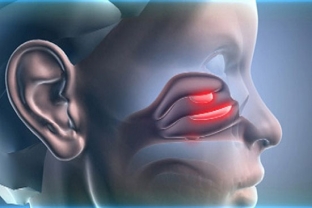Polyps in the nose grow more often in males and occur in every 25th person. Nasal polyps can also occur in children. A nasal polyp is formed against the background of a long-term inflammatory process in the nasal mucosa. The formation of a polyp is a compensatory reaction of the mucous membrane after the depletion of the body's defenses, which is tired of fighting inflammation in the nasal cavity. Then the mechanism of hypertrophic proliferation of the mucosa is activated, as a result of which polyps appear in the nose.
What symptoms of nasal polyps lead a patient to see a doctor?
The formation of polyps in the nose is a polyetiological process. Factors that contribute to the growth of polyps in the nose – features of the anatomical structure of the nasal cavity (narrow nasal passages, curvature of the nasal septum), the presence of chronic inflammatory diseases in the paranasal sinuses, as well as allergic diseases of the respiratory tract.
With a small size, the polyp does not make itself felt. With an increase in its size, nasal congestion and difficulty in nasal breathing are noted. Patients, as a rule, use vasoconstrictor drops, which at first bring an effect. Later they become ineffective, which is what patients complain about at an appointment with an otolaryngologist.
What are the dangerous consequences for children can have a polyp in the nose?
People with a nasal polyp breathe through a mouth that is constantly open and the lower jaw droops. Violation of nasal breathing is accompanied by increased fatigue, a decrease in mental and physical performance, often patients suffer from headaches and constant sleep disturbances. Among the complaints of patients there is also a violation of the perception of smells (anosmia), the sensation of a foreign body in the nasal cavity, a change in taste sensations, a constant runny nose and frequent sneezing. With a large size of the polyp in the nose, a nasal voice appears.
An overgrown polyp can block the entrance to the auditory tube, which is manifested by hearing loss, and in children - a violation of the development of speech. The appearance of a polyp in childhood is fraught with a violation of the formation of the facial skull and the system of teeth, which is often manifested by a violation of the formation of bite in children. In infants, nasal polyps can interfere with the sucking process, leading to the development of malnutrition of the child.
Treatment of nasal polyps can be either conservative or surgical.

Is conservative treatment of nasal polyps effective?
Conservative methods are used in the first stages of the treatment of nasal polyps. It is aimed at eliminating the factors and causes that provoked the development of hypertrophy of the nasal mucosa. These measures include the exclusion of the effect of food allergens on the body, the sanitation of foci of chronic infection of the nasopharynx, immunocorrection and antiallergic therapy.
Removal by thermal treatment is considered a conservative treatment for nasal polyps. The method is used if the patient has contraindications for surgery (blood clotting disorders, hypertension, heart and respiratory failure). The thermal effect on the polyp is exerted by a thin quartz fiber introduced into the nasal cavity. The temperature is 60-700C, after which the polyp becomes white and after 2-3 days is separated from the nasal mucosa. The doctor takes out the detached polyp with tweezers, and this is where the treatment ends.
In most cases, conservative therapy alone does not give the desired result - polyps may shrink, but do not disappear. After conservative treatment of nasal polyps, surgical treatment is performed.







Add a comment